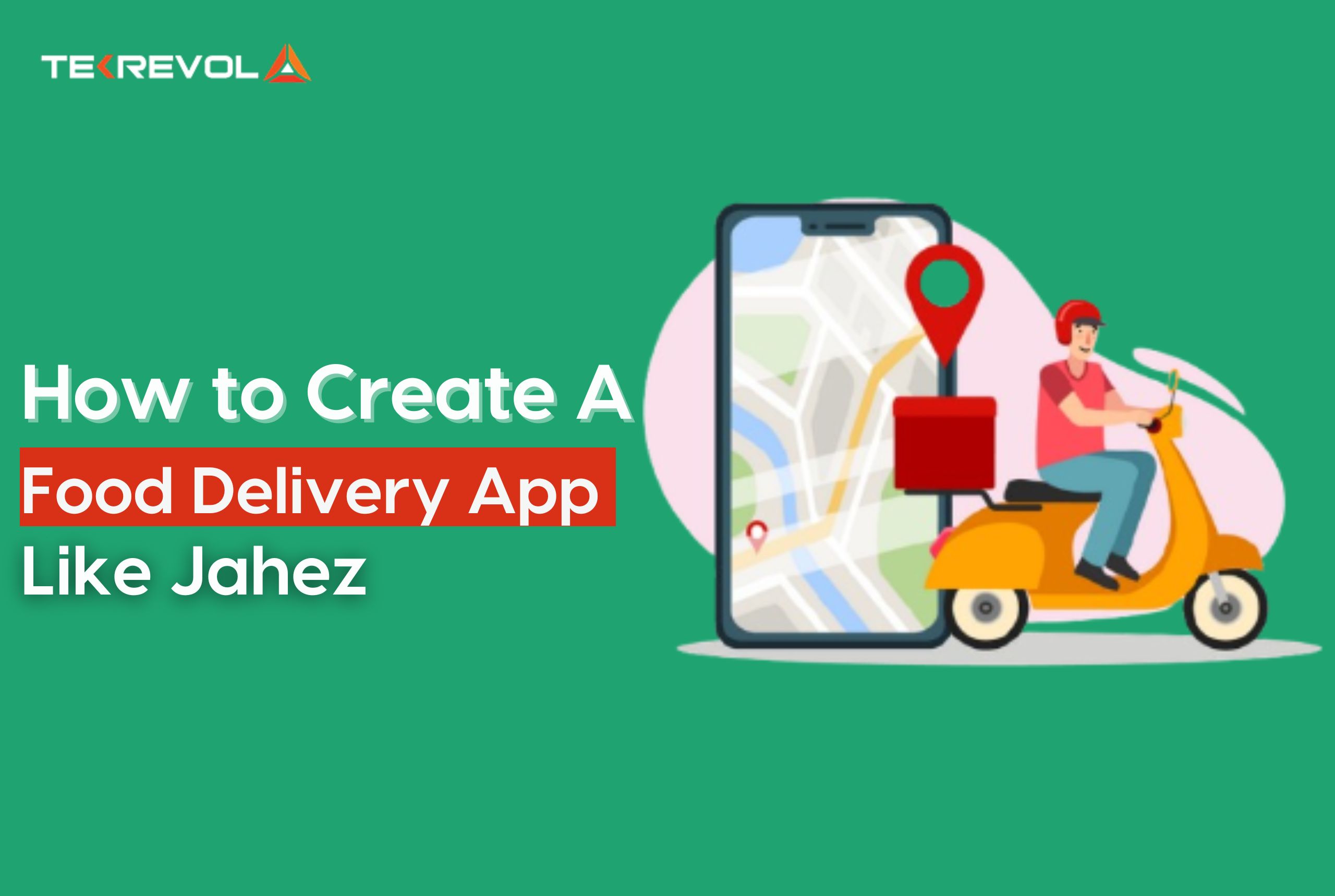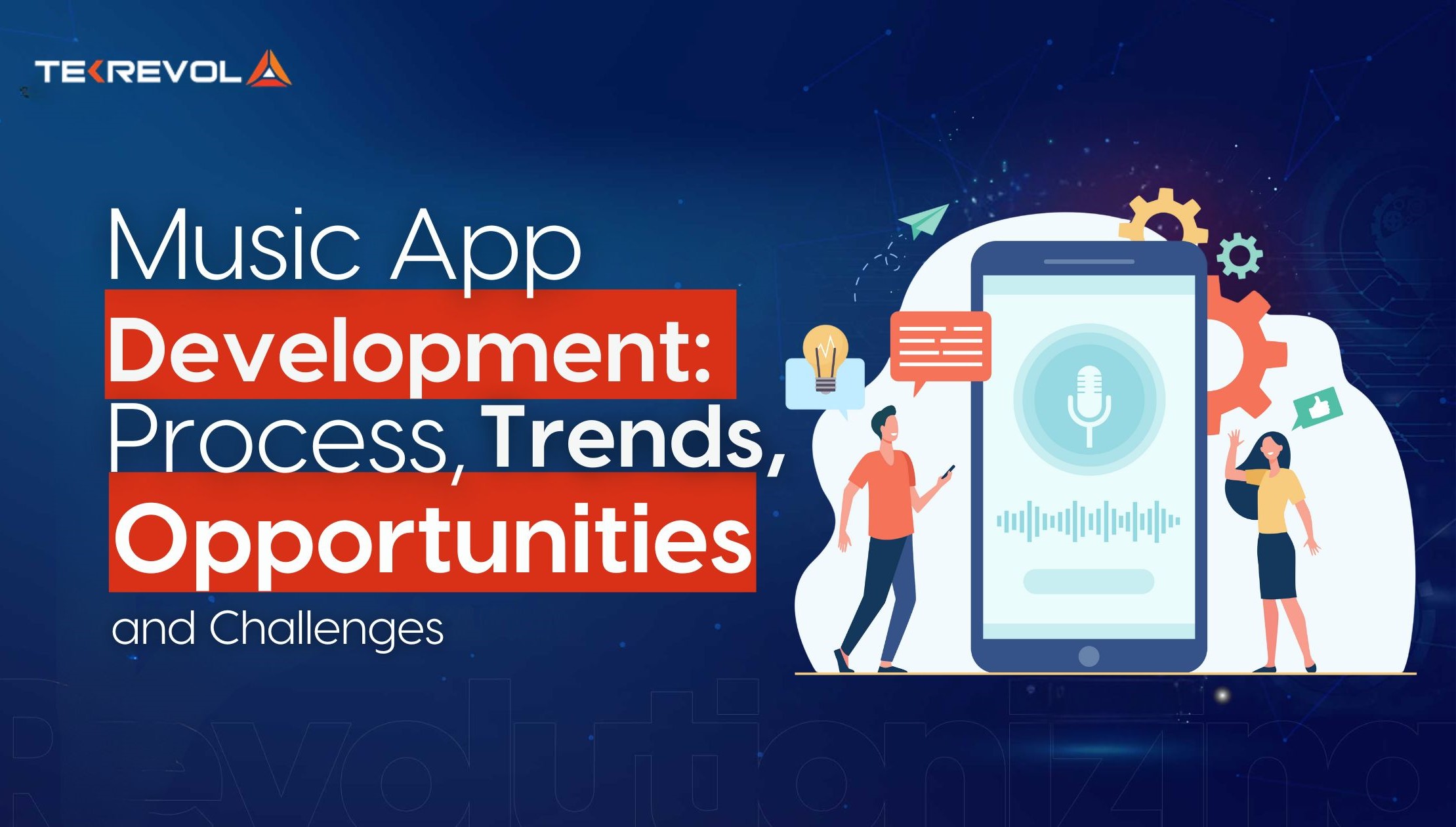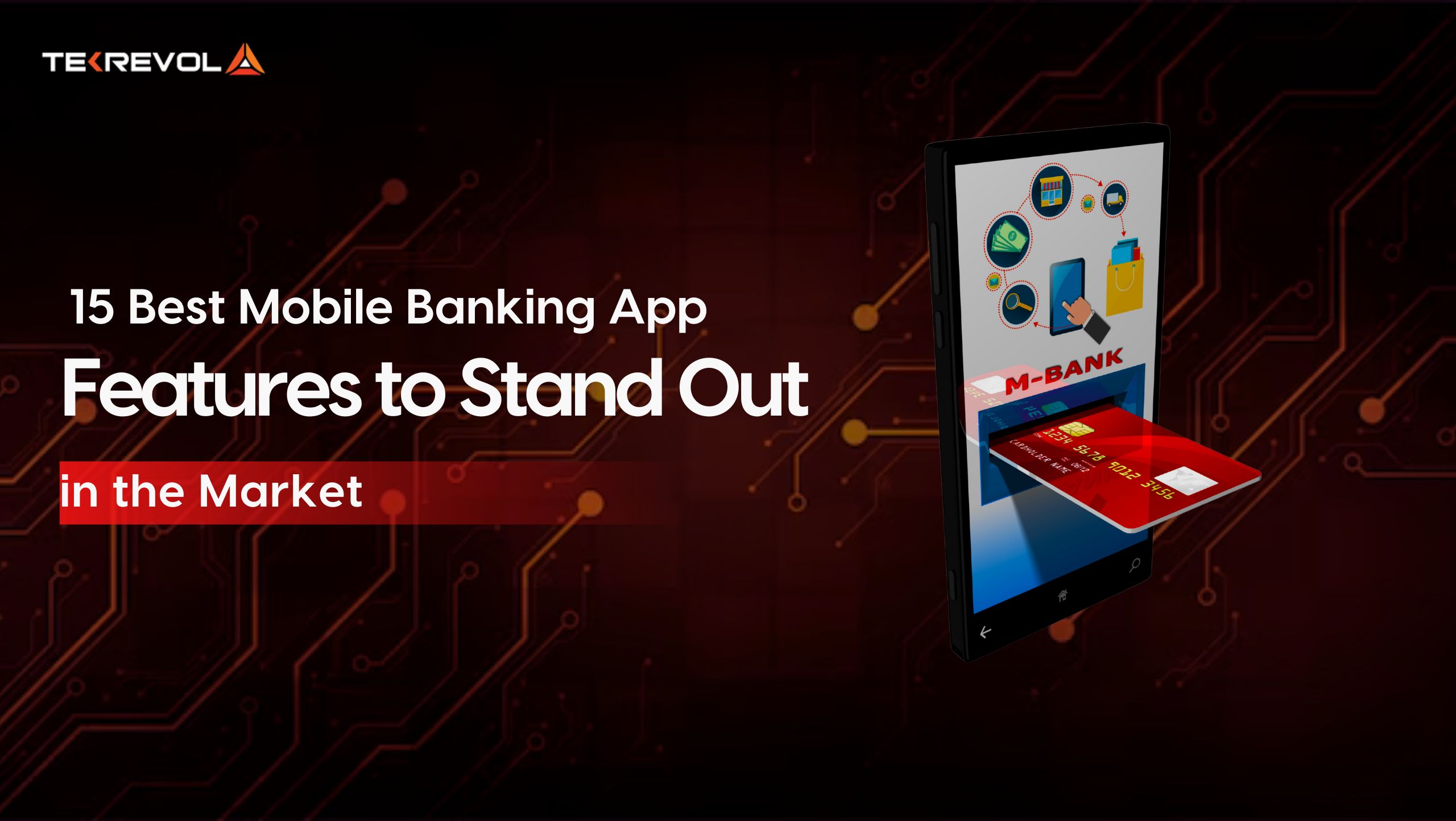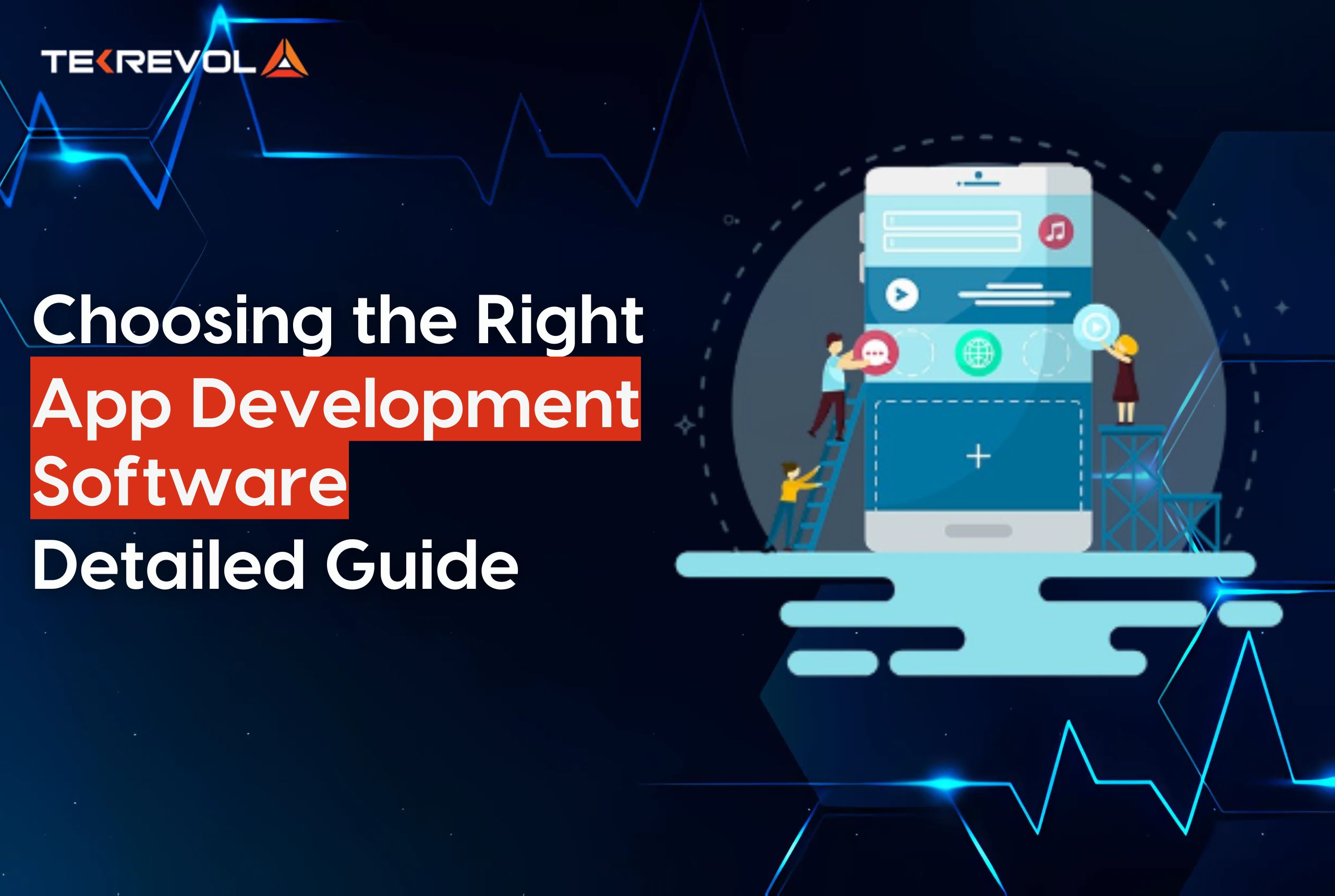Jahez is the market leader in Saudi Arabia’s rapidly growing food delivery ecosystem. With millions of users, tens of millions of orders per year, and a multi-billion dollar valuation, the platform has set a new benchmark for digital innovation in the region.
Creating an app like Jahez today means investing in the future of digital convenience. With Saudi Arabia’s food delivery market projected to hit $12.94bn by 2025, the growth potential is massive.
Having the idea is just the first step. The real challenge lies in execution. What features should your app include? How can you offer something better or different from market leaders like Jahez?
In this blog, we’ll walk you through the essential features, key development steps, and smart strategies to help you build a competitive food delivery app.
The Rapid Rise of the Food Delivery App Market
The food delivery world is not just growing, it’s exploding. Because of recent advancements in AI and changes in consumer buying behavior that change the way we eat, there is now a greater demand for instant and trusted food delivery app services than ever before.
So if you’re planning to build an app like Jahez, the figures speak for themselves: the time was truly ripe for taking action.
Investment in Food Delivery App Development
Here is a quick view of the major current market trends:
- Globally Valued: According to Grand View Research, the food delivery online market was worth $221.65 billion in 2022.
- Constant Growth: Food delivery market is likely to grow at a CAGR of 10.3% up to 2030, accelerating faster than many other digital service industries.
- Consumer Behaviour: Approx. 51% of people today prefer ordering food online to eating out, indicating quite a lot about the market shift when it comes to customer expectations.
Features That Will Make Your Food Delivery App a Success Like Jahez
To design a well-functioning food delivery app, you must focus on all three aspects of making the app usable: user experience, restaurant operations, and efficient delivery. Here is a breakdown of the significant features that must be included in your application:
| Feature Category | Feature | Description |
| User App Features | Easy Sign-Up & Login | Social media, email, and phone authentication for quick access. |
| Smart Search & Filters | Search for restaurants based on cuisine, location, ratings, and price. | |
| Real-Time Order Tracking | Live updates on order status and estimated delivery time. | |
| Multiple Payment Options | Support for credit/debit cards, mobile wallets, and cash on delivery. | |
| AI-Based Recommendations | Personalized suggestions based on user preferences and past orders. | |
| Schedule Orders | Allows users to place orders for future delivery. | |
| Ratings & Reviews | Customers can rate and review food and delivery services. | |
| Loyalty Programs & Discounts | Provide users with coupons, loyalty points, and exclusive discounts. | |
| Restaurant Panel Features | Restaurant Dashboard | Overview of orders, customer feedback, and revenue insights. |
| Menu Management | Easily add, update, or remove food items and adjust pricing. | |
| Order Management System | Real-time order handling, from acceptance to dispatch. | |
| Earnings & Commission Reports | Track revenue, payments, and commissions for each order. | |
| Marketing & Promotions | Ability to run targeted marketing campaigns and exclusive deals for customers. | |
| Delivery Partner Features | Profile & Registration | Delivery partners can sign up, verify documents, and manage availability. |
| Route Optimization & Navigation | AI-powered GPS to find the most efficient delivery routes. | |
| Earnings & Payouts | Track earnings and receive payments on a set schedule (daily or weekly). | |
| Order Alerts & Status Updates | Delivery partners receive notifications on new orders and real-time updates. | |
| Customer Communication | In-app chat or call features to resolve any issues with customers during delivery. | |
| Admin Panel Features | User & Restaurant Management | Admins can manage users, restaurants, and approve new listings. |
| Commission & Revenue Tracking | Track and manage commission rates and revenue generated from each order. | |
| Order & Delivery Monitoring | Admins can monitor all live orders, manage status updates, and optimize performance. | |
| Marketing & Push Notifications | Send promotional offers and important updates to users and restaurants. | |
| Advanced Features | AI-Powered Chatbots | Automate customer service and order inquiries using AI-powered chatbots. |
| Voice Search | Allow users to search for restaurants and dishes through voice commands. | |
| Smart Inventory Management | Automate restaurant inventory tracking for more efficient order fulfillment. |
How to Develop a Food Delivery App Like Jahez: A Step-by-Step Process
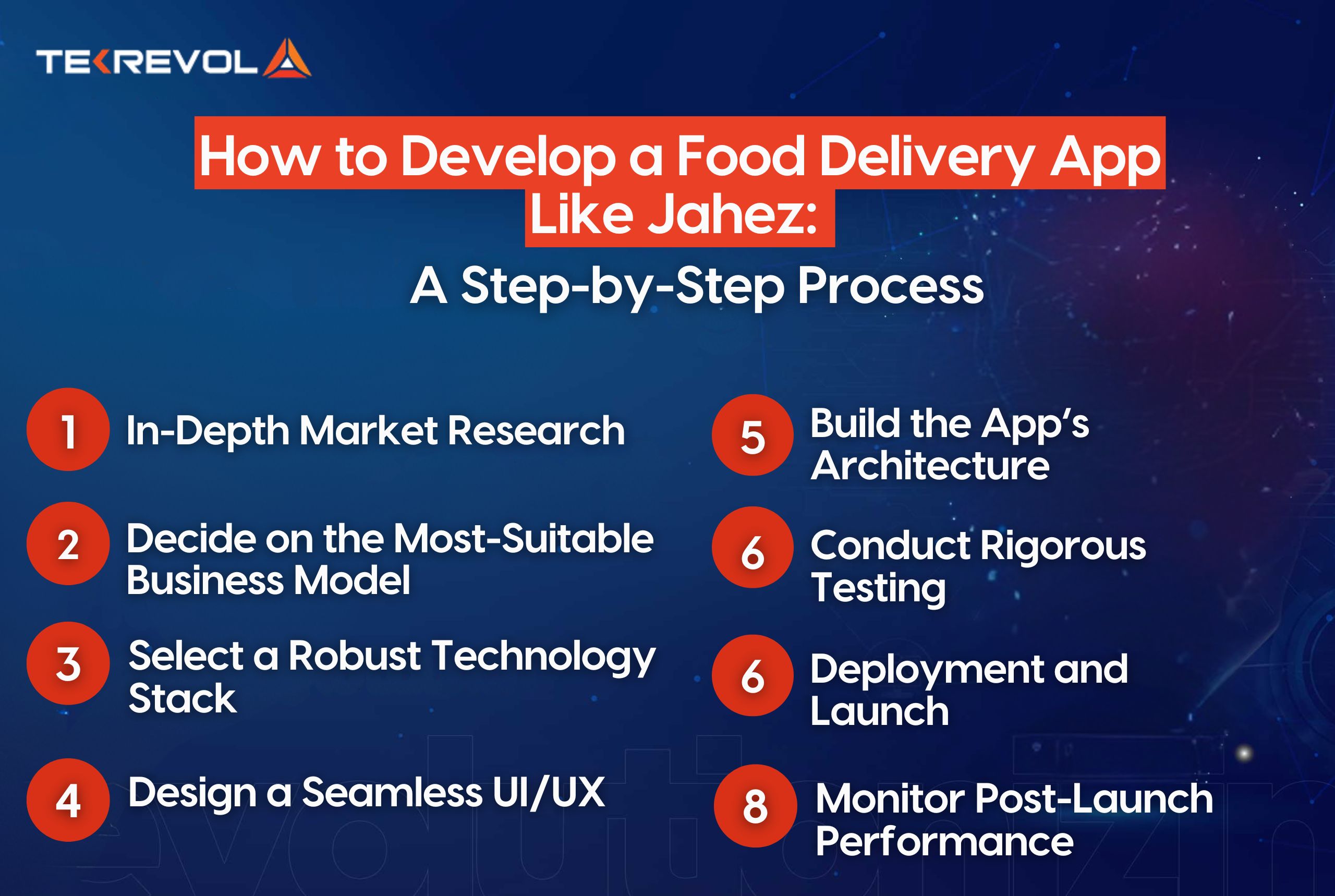
A thorough and methodical approach to creating a food delivery app like Jahez will ensure scalability and profitability, along with smooth operation for its users. Below is a guideline that will help you in turning out your food delivery app from start to end.
Step 1: In-Depth Market Research
Thoroughly examining the market before starting development is crucial. Knowing your target market’s requirements, rivals, and potential market trends will help you establish your application’s features and business plan. Relevant topics to study include:
- Target Audience: Identify demographic description, preferences, and ordering behavior in the geographic area of interest.
- Competitive Analysis: Analyze other seemingly successful food delivery applications like Jahez. Search for market gaps, projected opportunities, and possible differentiators.
- Revenue Models: Determine which business model talks the most to you: Aggregator, Cloud Kitchen, or Logistics Support.
Step 2: Decide on the Most-Suitable Business Model
Choosing a business model will directly affect the operations, revenues, and design of the app in question. Some of its examples are as follows:
- Aggregator Model: Serves as a platform connecting users with a wide variety of restaurants and earns a commission on each order.
- Cloud Kitchen Model: Provides delivery-only restaurants with no infrastructure for dine-in.
- Logistics Model: Provides a delivery service to restaurant partners for food and drinks that these restaurants prepare and pack.
Each model will require its own delivery, pricing, and partnership system. Choose a model based on what your research tells you.
Step 3: Select a Robust Technology Stack
Choosing the right technology stack directly affects the performance, scalability, and maintainability of the application. For food delivery applications, some of the tech stacks that may be recommended include:
- Front-end: React Native or Flutter for cross-platform applications (iOS and Android).
- Back-end: Node.js, Django, or Laravel for solid and scalable server-side development.
- Databases: PostgreSQL, Firebase, or MongoDB for storing data.
- Payment Gateway: Stripe, PayPal, or Razorpay for secure transactions.
- AI Integration: AI is used to automate personalized recommendations, demand forecasting, and customer support.
Step 4: Design a Seamless UI/UX
An easy-to-use interface and experience will help retain the user. The following must be considered:
- Simplicity: Navigation should always be kept as intuitive as possible so that a user can easily place orders and track delivery.
- Attractiveness: Use attractive visuals, high-quality food images, and crisp CTAs.
- Speed: Proper optimization of checkout, search, and all other app functions for performance.
Wireframes and prototypes designed using tools such as Figma or Sketch can give a good visualization to work with before the actual development starts.
Step 5: Build the App’s Architecture
At this stage, you’ll move into actual app development. The process involves both frontend and backend development:
- Front End Development: Design application interfaces for iOS, Android, and the web.
- Back End Development: Get on to developing everything on the server side, including the APIs and the database architecture.
- AI and Automation Integrations: All those AI features for personalized recommendations and route optimizations.
So, be careful to enforce all the security measures for user information and payment.
Step 6: Conduct Rigorous Testing
To ensure the platform is fully functional with mobile apps like Android or iOS, testing becomes a key factor. Testing types could include:
- Functional Test: Checking if all features, such as ordering, payment, and tracking functions, perform correctly.
- Usability Test: Check how user-friendly the application is for customer navigation.
- Performance Test: Check how fast or responsive the server is, given certain loads.
- Security Test: Verify secure payment procedures while ensuring data encryption for customers.
Step 7: Deployment and Launch
Once testing is complete and the app is optimized, it’s time for deployment. A few critical focus areas for a successful launch are:
- App Store Optimization (ASO): Optimize the description, title, and keywords of your app to gain visibility in the App Store and Google Play.
- Marketing Strategy: Promote the app through social media, ads, and influencer partnerships to drive downloads in the initial phase.
- User Onboarding: Provide a quick tutorial for first-time users to introduce them to the features and functionalities of the app.
Step 8: Monitor Post-Launch Performance
After the launch of the app, there will be continuous monitoring of its performance.
- User Feedback: Collect user feedback through in-app surveys and reviews to detect areas that need improvement.
- Analytics: Use app analytics tools to track user habits, trends in order, and other things at the top of the list.
- Bug Fixes & Updates: Fix any post-launch issues or bugs and schedule timely updates for the app’s healthy functioning.
- Need a Seamless Food Delivery App?
- We help you create an app that’s scalable, efficient, and easy to use.
Monetization Strategies for Building a Food Delivery App Like Jahez
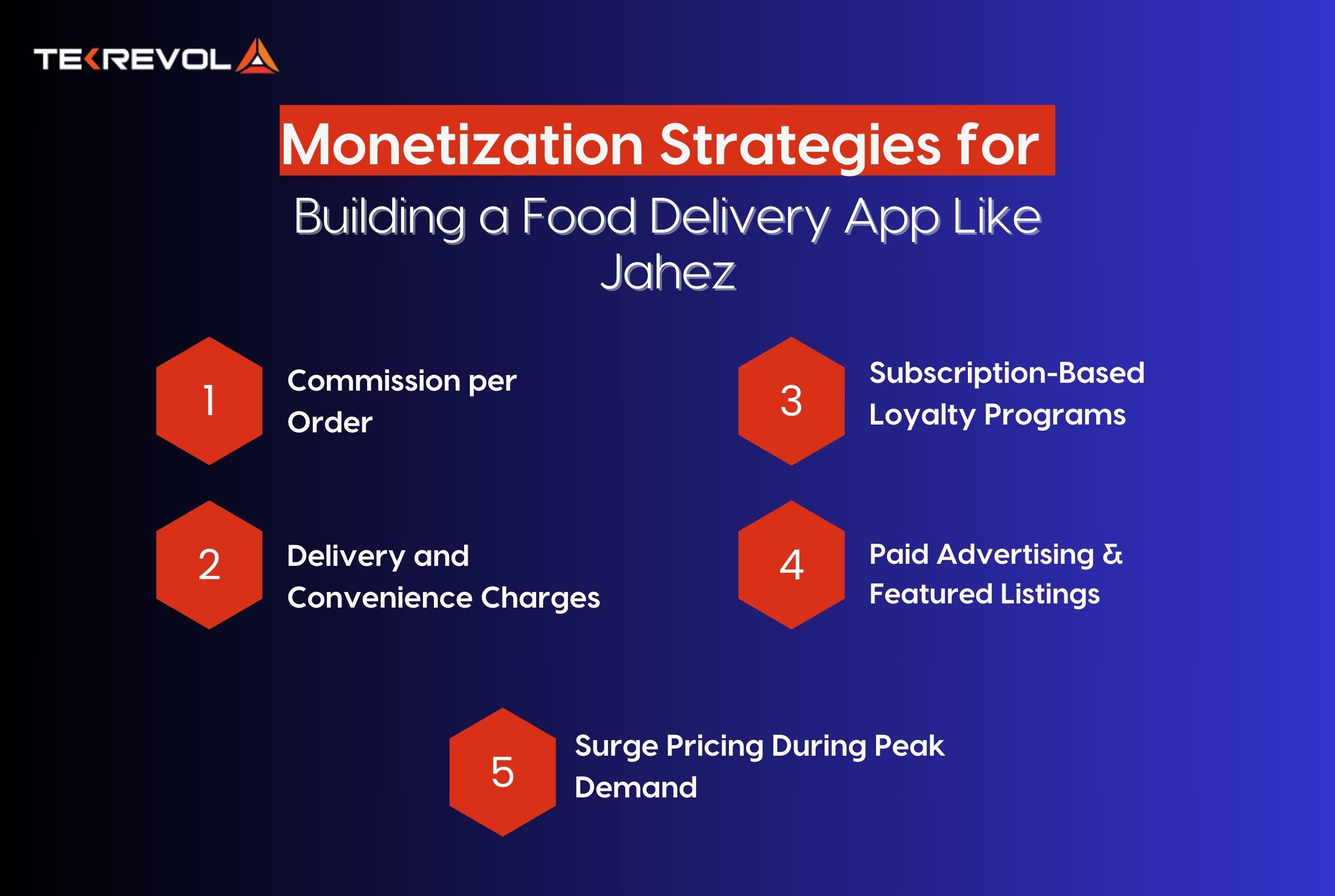
Developing a food delivery application like Jahez is merely the first move. For further success in the long run, a robust monetization structure is needed.
Platforms like Jahez, Uber Eats, and Talabat rose to the top not just because of their tech, but because they developed revenue models that served the needs of customers, restaurants, and their own business goals. Learn how you can do the same.
1. Commission per Order
The most popular way for food delivery apps to make money is by charging restaurants commission fees for each order that users place through the app.
How it works:
- Restaurants register and upload their menus in your application.
- You earn a commission on each order- either a flat amount (like $2 per order) or a percentage (like 15% of the order total).
- Visibility boost or promotional deals can also be purchased at higher commission rates.
Benefits
- Generates consistent revenues over order volume increases.
- Encourages restaurants to promote your app, as they own the fate tied to the app.
- Simple to scale with minimal operational changes.
Tip: Create tiered commission plans based on restaurant categories or order volumes.
2. Delivery and Convenience Charges
The other revenue stream is delivery fees and small order fees for guest convenience.
How this works:
- Customers pay an extra fare calculated from the distance between the restaurant and the delivery point.
- The fees can increase automatically during peak times.
- Small order fees apply to orders below a certain value (say $10) to keep chasing delivery profits.
Benefits
- It protects your bottom line when the average order is not that great.
- Dynamic pricing will motivate customers to put together higher-order baskets, increasing your revenue.
Pro Tip: Allow customers to “waive” the delivery fee when they join the loyalty program, thus driving more subscriptions.
3. Subscription-Based Loyalty Programs
Food delivery applications now rely on subscription models for repeat usage and predictable monthly income.
How this works:
- There will be a premium membership (probably $9.99/month) in which one gets free deliveries, special handicap discounts, and priority support.
- The members also receive early access to promotional events.
Benefits:
- Lock customers into your platform, increasing retention.
- Creates a dependable subscription income other than daily orders.
- Encourages more frequent ordering because customers want to “maximize” their membership value.
Pro Tip: Run an offer for a free trial or discount the first month to attract people to try your subscription plan.
4. Paid Advertising & Featured Listings
Advertising is one of the biggest and most lucrative sources of hidden revenue. Restaurants and brands would burn their fingers just to buy space and time to reach more customers.
How it works:
- Restaurants can pay to rank higher.
- Place exclusive discounts or promotional campaigns on the homepage or banners of the app.
- Other companies that offer goods other than beverages may also decide to include advertisements on the app. Ads for groceries, for instance, may appear in the app.
Benefits:
- It will generate an additional revenue channel, but at an extremely high margin.
- It will improve sales for a particular kind of restaurant, thereby making it more loyal to the platform.
Tip: Provide restaurants with data on the effectiveness of the advertisements they have placed. Transparency like this fosters confidence with repeat customers and advertising partners.
5. Surge Pricing During Peak Demand
Maximizing profits during high-demand periods is important-customers expect some price variation at peak times.
How it Works:
- When demand is high (weekends, holidays, and rainy days), the delivery fees automatically increase.
- Implement “priority delivery,” wherein customers can pay to get faster service.
- Restaurants can pay to guarantee that their deliveries will be prioritized when demand surges.
Benefits:
- This balances supply and demand during busy periods.
- This enables earning more while keeping the speed and quality of delivery intact.
Pro Tip: Use AI to forecast demand increases so that restaurants and drivers are notified to prepare accordingly.
Breaking Down the Cost of Building a Food Delivery App Like Jahez
The final cost of developing a food delivery application similar to Jahez may vary depending on several aspects such as the features desired, the technology stack, and the location of the development team. Good knowledge of these cost components will enable effective planning of the budget.
Here’s a complete rundown of the causes of food delivery application development costs.
| App Type | Estimated Cost | Estimated Timeline |
| Basic Food Delivery App | SAR 37,500 – SAR 150,000 ($40,000 – $80,000) | 3–4 months |
| Medium Complexity Food Delivery App | SAR 150,500 – SAR 400,000 ($80,000 – $200,000) | 4–6 months |
| High-End Food Delivery App | SAR 400,000 – SAR 1,100,000+ ($300,000 – $500,000+) | 9 months or more |
Note: The cost mentioned above is just an average estimate. For a more detailed and accurate cost breakdown, it’s advisable to work with a reputable app development company in Saudi Arabia.
- Want to Know the Exact Cost of Building Your App?
- Use our cost calculator or connect with our experts to receive a tailored estimate.
Top Reasons Businesses Should Invest in a Food Delivery App Like Jahez
Consumer patterns have changed with time. Rather, the food delivery apps have become more than just a convenience factor; instead, they play an integral role in the restaurant industry today.
A platform such as Jahez has now turned around a whole different dimension of the restaurant experience, with real-time tracking, speedy services, suggestions powered by artificial intelligence, etc. At this point, digital transformation is no longer an option for businesses but has become mandatory for survival.
Here are all the compelling reasons for designing a food delivery app like Jahez that could be one of the smartest business decisions for you:
1. Reach a Wider Audience Beyond Your Walls
Relying on foot traffic was the only way restaurants once survived. Today’s patrons demand and expect convenience, and they expect it fast. A customized food delivery application will allow you to:
- Reach out to more customers beyond your immediate neighborhood.
- Encourage people to order online, convenient take-out, and door delivery.
- Improve efficiency via AI-managed order and inventory supervision.
In a nutshell, a well-designed application brings in some streams of revenue not accessible through standard dine-in service channels.
2. Cut Out the Middleman & Boost Your Profits
While using services such as Uber Eats or Talabat might feel simpler, the commission fees (which can go as high as 30 percent) eat into your margins.
Build your food delivery app and:
- Let out a deep sigh of relief and keep most of your earnings minus those hefty third-party fees.
- Create customer loyalty programs and promotions directly for your customers.
- Owning your customer relationships, along with brand loyalty, repeat business, etc.
Owning the platform translates as owning the profit.
3. Leverage AI and Automation for a Smarter Business
There are currently benefits associated with the emerging technologies around which food delivery apps should revolve. AI-powered food delivery apps now offer much more:
- Custom recommendations according to the user’s interaction with the app.
- Predictive analytics for optimization of menu pricing and demand forecasting.
- Delivery management automation for reduced waiting time and increased efficiency.
When it comes to modern technology, apps like Jahez have shown themselves to be ahead of the curve. Using AI has improved customer satisfaction in addition to operational excellence.
4. Stay Ahead in an Evolving Market
The ever-changing world of food deliveries puts great expectations on customers. If you’re not innovating, you’re already behind.
When you invest in food delivery app development, you can:
- Provide a seamless, better user experience than your rivals.
- Be responsive when it comes to market changes and new consumer patterns.
- Bring your brand to the limelight as a trendsetter in local food delivery.
Innovate today to remain relevant tomorrow.
Partner with TekRevol to Build Your Food Delivery App
With over 8 years of experience in the industry, TekRevol is a leading name in on-demand app development. Our experts have delivered many innovative, state-of-the-art solutions in various domains, primarily specializing in designing easy-to-use and user-centric food delivery applications. We understand the market intricacies and assist you in creating an application that stands out from the crowd.
As the premier on-demand app development company, TekRevol integrates the latest technology with valuable industry insights. This would ensure that your food delivery app embraces all modern features, works seamlessly, and is scalable to meet the needs of users and restaurant owners. Our emphasis is on high-quality delivery and custom solutions concerning your business objectives.
At TekRevol, we collaborate closely with you to understand what you want to accomplish, maintaining full transparency throughout every step of the way. This means you are kept up-to-date, and we ensure that the app development process is aligned with your vision, goals, and expectations. Your success is our goal.
- Start Building Your App Today
- We help you design and develop a food delivery app that meets your unique needs.

 33 Views
33 Views April 29, 2025
April 29, 2025